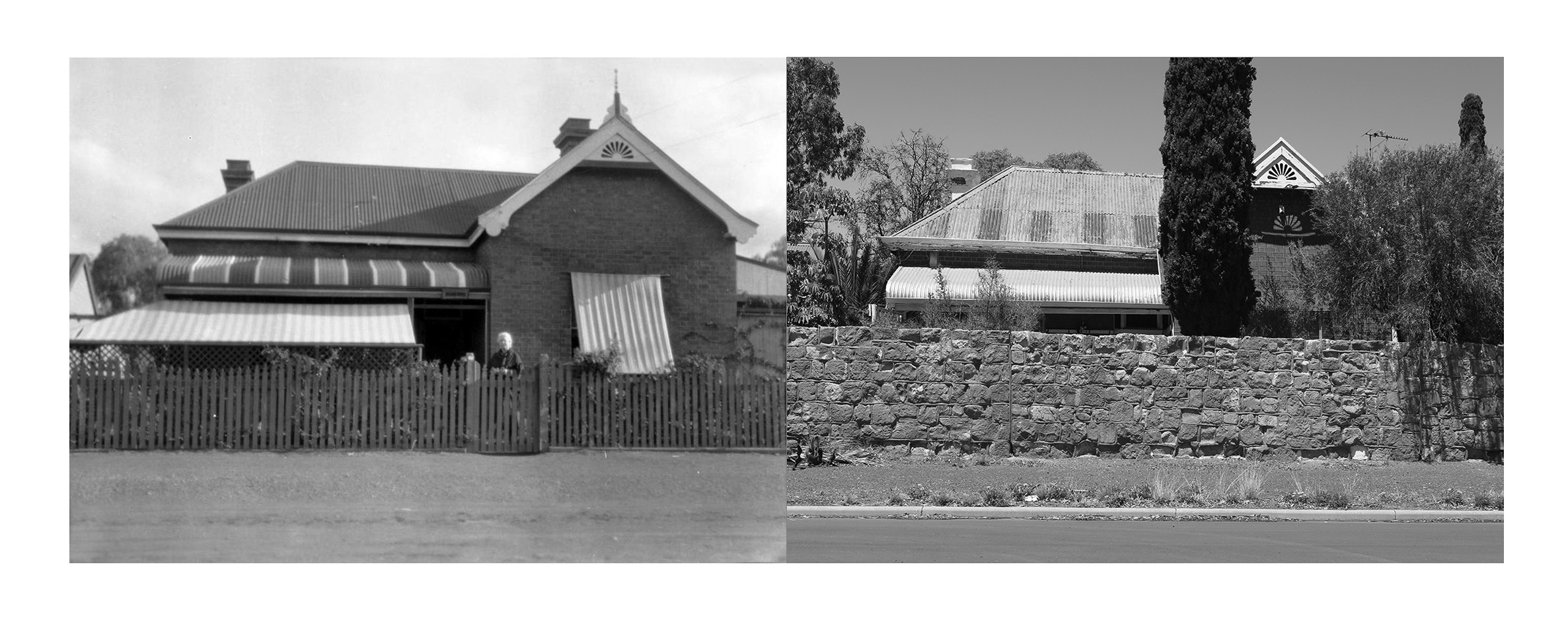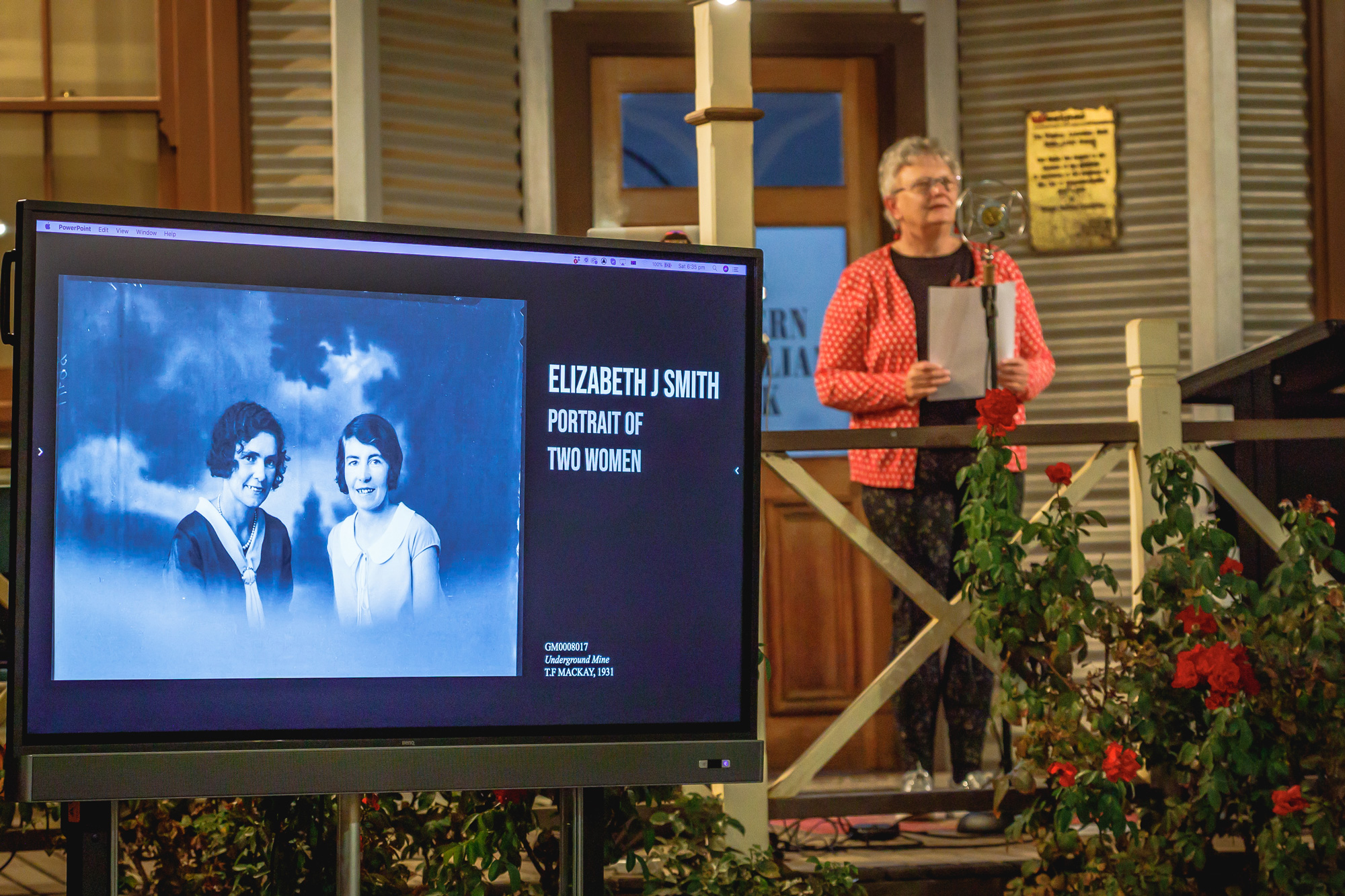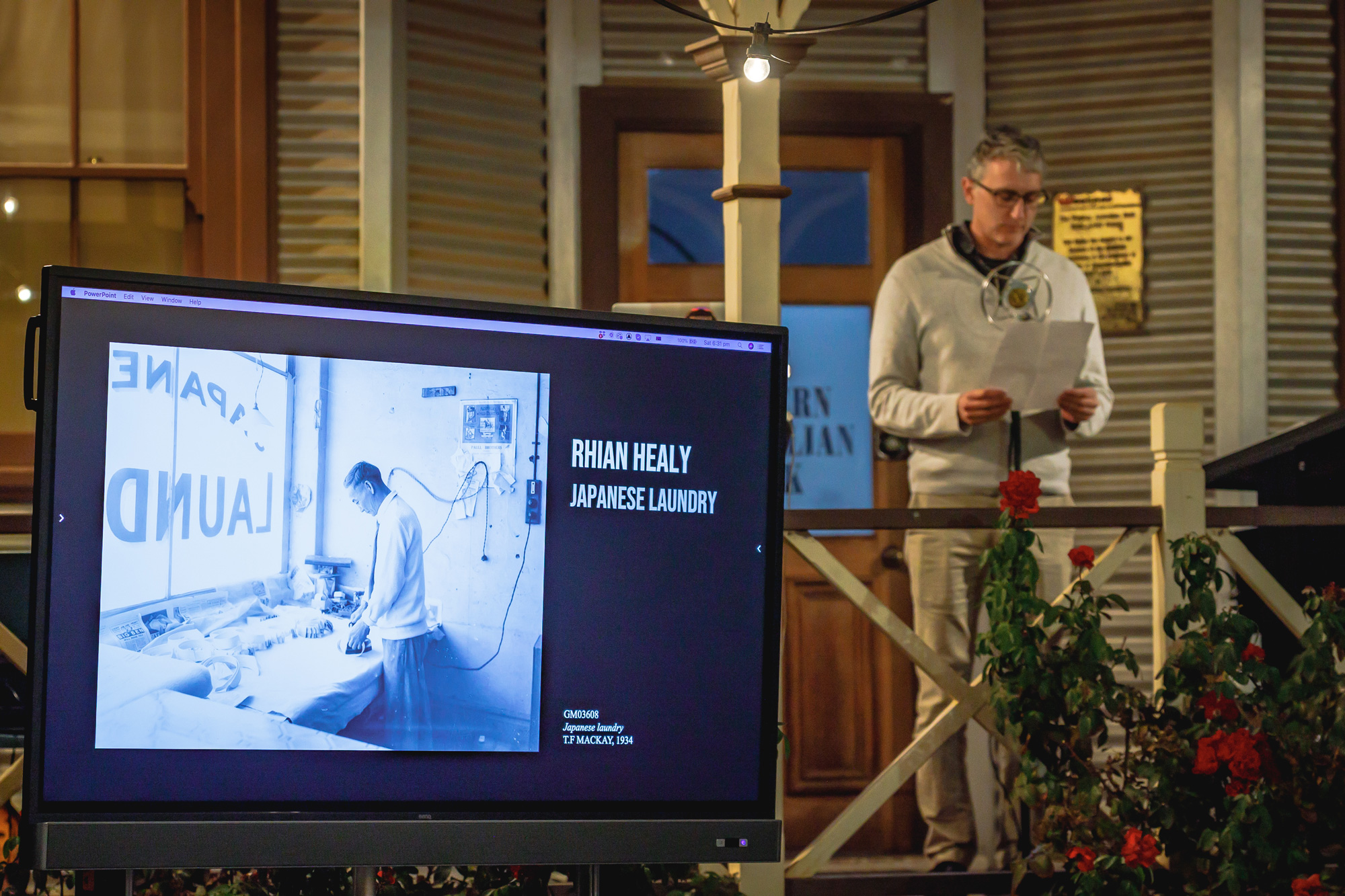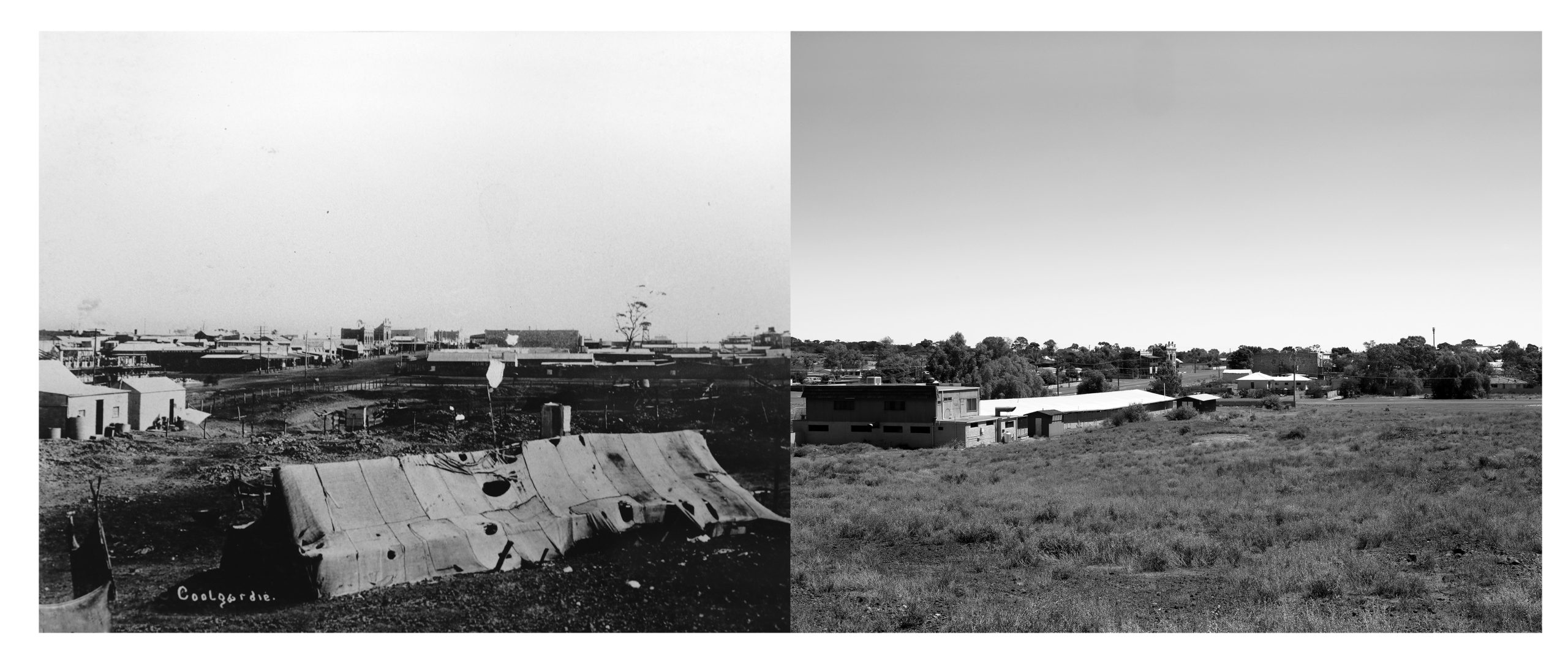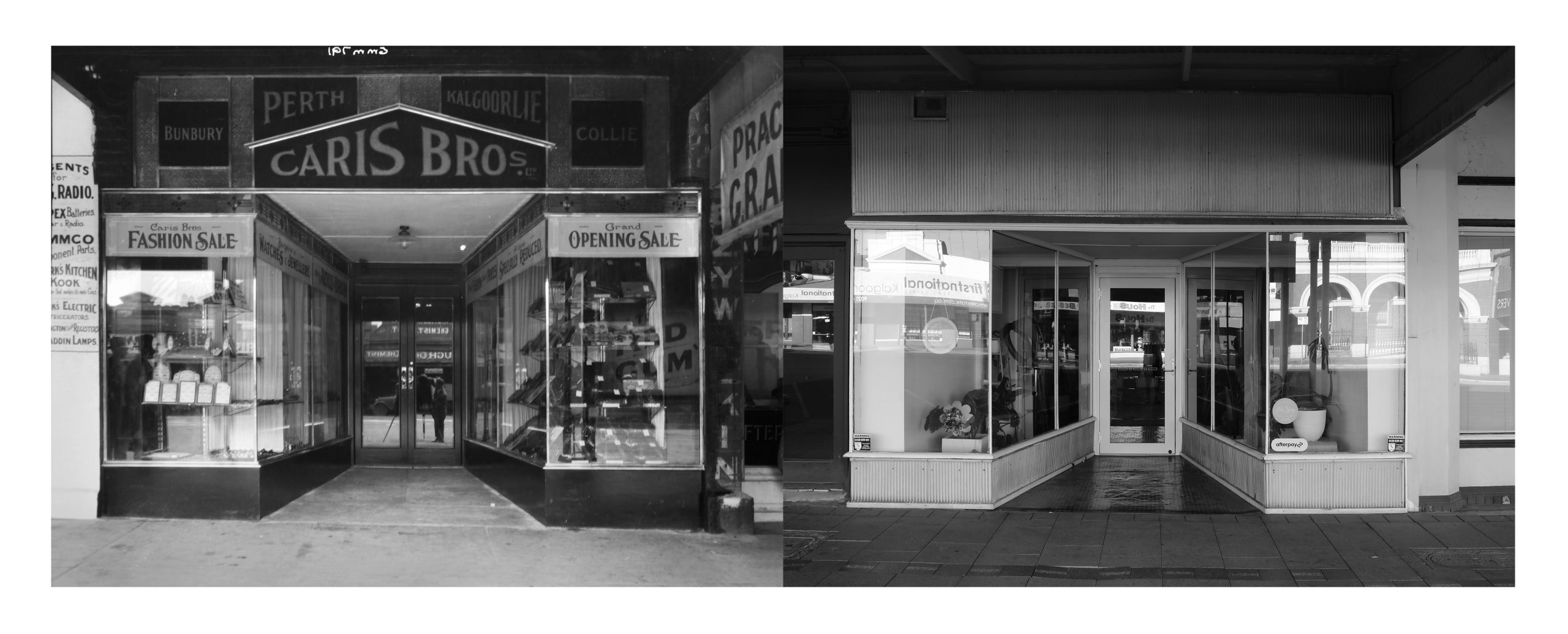“Dwyer and Mackay were entrenched within Kalgoorlie community; the buildings and people and events they documented were intimately familiar to them. I made a point of seeking that same familiarity” said Brett Leigh Dicks.
In 2023 Brett Leigh Dicks was Artist in Residence at the Museum of the Goldfields, through ART ON THE MOVE’S Activating Collections program. Brett approaches the medium of photography through an archaeological lens, exploring the relationship between human society and the environment.
For his residency, Brett’s focus was on the historic Dwyer & Mackay Collection and using the technique of repeat photography to recreate images in the collection. Taken from the same vantage point (only one hundred years later) the resulting photographs expose the passing of time and shifts in the fabric of the Kalgoorlie-Boulder landscape.
Here, Brett shares some insights into his residency project.

Image credit: Image from the Dwyer & MacKay Collection (on the top) side-by-side with image of the same location taken by Brett-Leigh Dicks (on the bottom). Image courtesy the artist and Museum of the Goldfields.
What attracted you to the Activating Collections program and why were you drawn to this location?
Having spent the past twenty years living and working in California, Kalgoorlie was the first place I visited outside of the Perth area after relocating to Fremantle. It reminded me of some of the towns and cities in the American West. The landscape and remoteness felt strangely familiar, and I was drawn to its unique identity and character.
What were the key ideas you wanted to explore?
My focus was the exploration of time. I still recall the initial impression Kalgoorlie had on me when I drove along downtown Hannan Street; it was like time had stood still. There are very few modern intrusions with heritage and preservation is firmly entrenched within the city’s character.
I wanted to capture some of that, and after discovering the Dwyer & Mackay Collection, a concept quickly fell into place. It’s a remarkable archive that offers a comprehensive survey of life in Kalgoorlie across five decades. Being familiar with the Repeat Photography movement in the United States and some of its leading practitioners (such as Mark Klett), the collection felt like the perfect muse.
My idea was to create images based on the Dwyer and MacKay photographs. The new set of images would be identical to the originals in terms of framing and lighting, thus allowing time to be the variable.
Image credit: Images from the Dwyer & MacKay Collection (on the left) side-by-side with images of the same location taken by Brett-Leigh Dicks (on the right). Images courtesy the artist and Museum of the Goldfields.
What has it been like spending time in the community?
I got to know the people working in the businesses that occupied the buildings I was photographing while also knocking on the doors of the residences and introducing myself to the owners. And people responded in kind; property owners were more than happy to move their motor vehicles out of the line of site in my photograph and went out of their way to accommodate requests to document interiors. They welcomed me back multiple times. At times, I spent longer chatting with people while on location than I did photographing.
I did a tremendous amount of research prior to arriving in Kalgoorlie, but I learned even more about the place once I was out there immersing myself in the community.
Can you share a little on the poetry event you initiated?
The Dwyer & Mackay Collection is extensive, containing over 10,000 images. The two photographers operated out of their own studios and while they documented mostly street scenes, businesses, residences, and events, portraiture was also a huge part of their business operation.
I wanted to respond to the portraits and had the idea of incorporating ekphrastic poetry into the project. I selected 32 portraits that I felt represented the collection as a whole and with the assistance of WA poet Natalie Damjanovich-Napoleon, we devised and promoted the poetry competition.
From almost one hundred entries, twelve poems were selected for inclusion within the project with a winning poem selected from both the adult and student categories along with ten finalists. An evening of poetry was staged at the Museum of the Goldfields which was part of the 2023 Australian Heritage Festival.
Image credit: Looking Forward/Looking Back Poetry Event at Museum of the Goldfields, 2023. Photography by Chuck Thomas.
How did you access the Dwyer & Mackay Collection? Can you share a bit on this process?
The Dwyer & Mackay Collection sparked my curiosity in 2019 during my first visit to the Museum of the Goldfields. I then found images on the WA Museum’s website which introduced me to the breadth of the collection.
Given that a portion of the collection is digitised, once the project was approved, that greatly assisted with the research phase of the project. Using these images, I could identify, research, and map locations.
I was expecting to access the non-digitalised collection in Kalgoorlie but the archive had recently been relocated to the Museum’s Welshpool facility. So I arranged access to the non-digitalised collection in Welshpool and made a copy of all the original photographs of interest and recorded all available information. I examined the images for as much locational information as possible – signs, street numbers, adjoining buildings – and used Google Maps to start identifying locations.
While most photographs did not contain addresses, sometimes the records included the name of the person who commissioned the original photograph and the year it was created. With that information, I used old residential and business records to associate street addresses to names and traipsed the streets looking for those addresses and identifying features within the photographs.
For the iconic structures, identifying the building and location was very straightforward. For others, it was a painstaking task of using Google Maps Street View to examine every street within the city to identify structures.
Image credit: Images from the Dwyer & MacKay Collection (on the left) side-by-side with images of the same location taken by Brett-Leigh Dicks (on the right). Images courtesy the artist and Museum of the Goldfields.
How has the residency impacted your practice? What were your expectations?
It’s difficult to carve out a living as an artist so I am typically working on multiple projects at the same time. To have the support to focus solely on this project alone was a luxury I have never enjoyed before.
When you set out on a self-funded project there are limitations, the greatest one typically being how long you spend on location. When diving into the project I expected a much greater difficulty in accessing private locations. Being on location for so long allowed me to become part of the local community. I was overwhelmed by how people pitched in to assist me.
What do you see as the role of today’s museum?
Both historic and contemporary collections are of immense importance to society, but equally important is the context in which they are presented. Storytelling in 2023 is very different to the way it was in 1923 and while the stories don’t change, the way they are told or presented do. I think the role of the modern museum is to present its collection in a way that will engage a contemporary audience.
How do you understand this term ‘activating collections’?
It is important to scrutinise, interrogate, or re-evaluate a collection as the contemporary socio-political landscape shifts. At the very least we should be asking questions about it’s history and relevance and what it represents. The obvious examples of this are stolen art and artefacts along with culturally sensitive objects being displayed out of context.
For me, ‘activating collections’ encompasses the various means of continually engaging with a collection from different perspectives. Scrutinising a collection will offer a different view or interpretation of it and a new understanding.
Image credit: Images from the Dwyer & MacKay Collection (on the left) side-by-side with images of the same location taken by Brett-Leigh Dicks (on the right). Images courtesy the artist and Museum of the Goldfields.
What were some of your favourite moments or most exciting discoveries during the residency?
Visiting the Lloyd George Mine site was a big highlight. Another was finding a box containing a shattered glass plate negative. After piecing together the broken negative on a lightbox, I photographed the complete image and created a positive photograph. It depicts a beautiful portrait of the Smith family, with the facture lines and edges giving the image an ethereal feel. Recreating that image and bringing it back to life after all this time was very exciting.
But the greatest discovery of the project was the degree to which Kalgoorlie/Boulder values its history and heritage. So many of the buildings within both Dwyer and MacKay’s photographs are still standing, which is a wonderful testament to the degree to which the region values its heritage.
What’s next for you?
Prior to the residency I was working on a series called Nuclear Landscapes which examined the legacy of atomic energy on the American landscape. I am now commencing a similar exploration which examines the legacy of nuclear energy upon the Australian landscape. This will include subjects ranging from the various British atomic testing sites and their associated impact to uranium mines and processing plants, waste facilities, and sites of nuclear-related accidents and incidents.
Applications for ART ON THE MOVE’s 2024 Artist in Residence Program are open until April 26. Visit our website to find out more.
Brett Leigh Dicks is an Australian/American photographer who shares his time between the United States and Australia. His photographic endeavours have led him to explore the world’s natural and urban landscapes with the resulting imagery spanning Australia, America and Europe. Brett primarily investigates the landscape and the fragile ties that it shares with human history, shining a light on humanity’s socio-political indiscretions. In addition to his own photographic pursuits, Brett has written extensively on the subject of photography along with curating exhibitions for public and private galleries and museums.
For more information visit brettleighdicks.net

